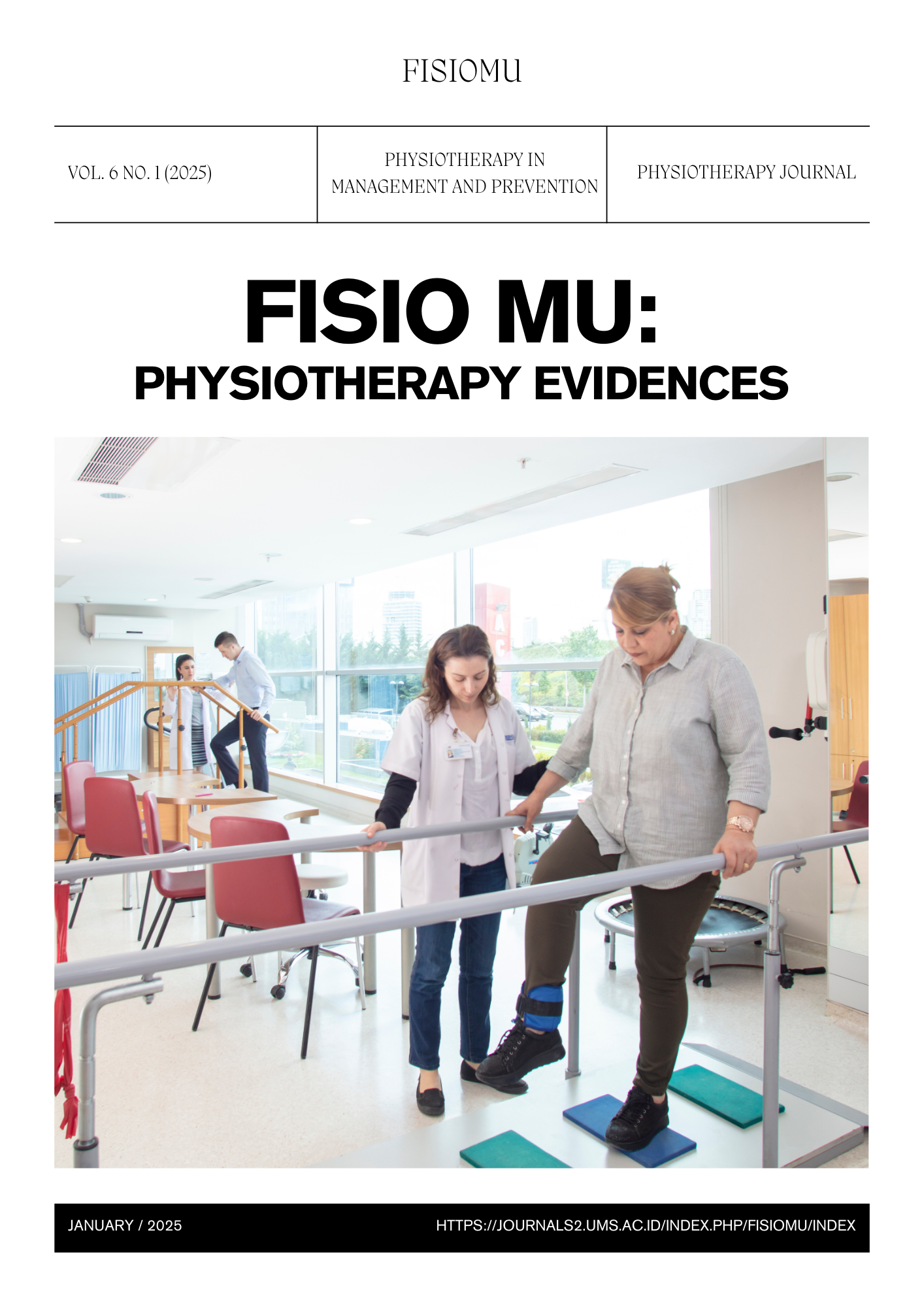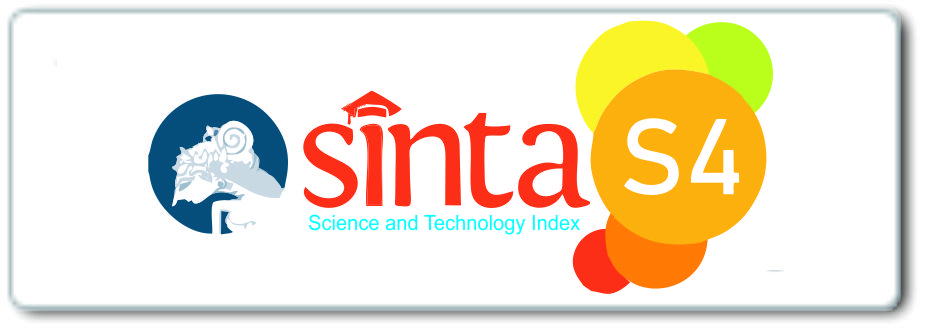The Effect of Dual-Task Texting on Cervical Muscle Activity in Smartphone Users
DOI:
https://doi.org/10.23917/fisiomu.v6i1.7237Keywords:
smartphone, dual-task, texting, muscle activityAbstract
Introduction: Current technological developments are very fast making it easier for people to carry out all activities via smartphones. One of the frequently used smartphone functions is typing and sending messages. Typing and sending messages can be done anytime and anywhere. Typing messages on a smartphone while walking falls into the dual-task category. This study aims to analyze the effect of using dual-task texting on cervical region muscle activity on smartphone users, where smartphone users type messages while walking. Methods: The method used is a single-group repeated experimental design. A total of 36 subjects consisted of 19 women and 17 men with an age range of 21.28 ± 0.97 years. The parameter measured is the upper trapezius muscle activity. Subjects were asked to walk in five conditions, namely baseline walking, texting flashcard 1, texting flashcard 2, texting flashcard 3, and texting flashcard 4. All experiments recorded upper trapezius muscle activity using an electromyograph. Results: The results of repeated measure ANOVA stated that typing on a smartphone had a significant effect (p < 0.05) on young respondents increasing activity of the upper trapezius muscle. Conclusion: Dual-task texting significantly affects cervical region muscle activity, particularly in the upper trapezius muscle on the right side, which has the potential to increase the risk of muscle fatigue in smartphone users.
Downloads
References
AlAbdulwahab, S. S., Kachanathu, S. J., & AlMotairi, M. S. (2017). Smartphone use addiction can cause neck disability. Musculoskeletal Care, 15(1), 10-12. https://doi.org/10.1002/msc.1170 DOI: https://doi.org/10.1002/msc.1170
Alt, D., & Boniel-Nissim, M. (2018). Parent–Adolescent Communication and Problematic Internet Use: The Mediating Role of Fear of Missing Out (FoMO). 39(13), 3391-3409. https://doi.org/10.1177/0192513x18783493 DOI: https://doi.org/10.1177/0192513X18783493
Annur, C.,Mutia.(2022). Katadata Media Network.https://databoks.katadata.co.id/datapublish/2022/03/23/ada-2047-juta-pengguna-internet-di- indonesia-awal-2022
Chen, P. L., & Pai, C. W. (2018). Pedestrian smartphone overuse and inattentional blindness: an observational study in Taipei, Taiwan. BMC Public Health, 18(1), 1342. https://doi.org/10.1186/s12889-018-6163-5 DOI: https://doi.org/10.1186/s12889-018-6163-5
Crowley, P., Vuillerme, N., Samani, A., & Madeleine, P. (2021). The effects of walking speed and mobile phone use on the walking dynamics of young adults. Scientific Reports, 11(1), 1237. https://doi.org/10.1038/s41598-020-79584-5 DOI: https://doi.org/10.1038/s41598-020-79584-5
Gustafsson, E., Thomée, S., Grimby-Ekman, A., & Hagberg, M. (2017). Texting on mobile phones and musculoskeletal disorders in young adults: A five-year cohort study. Applied Ergonomics, 58, 208-214. https://doi.org/https://doi.org/10.1016/j.apergo.2016.06.012 DOI: https://doi.org/10.1016/j.apergo.2016.06.012
Hall, S. J., & Lysell, D. (1995). Basic biomechanics.
HAMID, H. (2018). PENGARUH PENGGUNAAN SMARTPHONE TERHADAP HASIL BELAJAR MURID SDN 209 INPRES GARANTIGA KECAMATAN SIMBANG KABUPATEN MAROS UNIVERSITAS MUHAMMADIYAH MAKASSAR]. MAKASSAR.
Hyong, I. H. (2015). The effects on dynamic balance of dual-tasking using smartphone functions. J Phys Ther Sci, 27(2), 527-529. https://doi.org/10.1589/jpts.27.527 DOI: https://doi.org/10.1589/jpts.27.527
Kietrys, D. M., Gerg, M. J., Dropkin, J., & Gold, J. E. (2015). Mobile input device type, texting style and screen size influence upper extremity and trapezius muscle activity, and cervical posture while texting. Applied Ergonomics, 50, 98-104.https://doi.org/https://doi.org/10.1016/j.apergo.2015.03.003 DOI: https://doi.org/10.1016/j.apergo.2015.03.003
Kim, S. H., Jung, J. H., Shin, H. J., Hahm, S. C., & Cho, H. Y. (2020). The impact of smartphone use on gait in young adults: Cognitive load vs posture of texting. PLoS One, 15(10), e0240118. https://doi.org/10.1371/journal.pone.0240118 DOI: https://doi.org/10.1371/journal.pone.0240118
Krasovsky, T., Weiss, P. L., Kizony, R. J. G., & posture. (2017). A narrative review of texting as a visually-dependent cognitive-motor secondary task during locomotion. 52, 354-362. DOI: https://doi.org/10.1016/j.gaitpost.2016.12.027
Lee, M., Hong, Y., Lee, S., Won, J., Yang, J., Park, S., Hong, Y. (2015). The effects of smartphone use on upper extremity muscle activity and pain threshold. J Phys Ther Sci, 27(6), 1743-1745. https://doi.org/10.1589/jpts.27.1743 DOI: https://doi.org/10.1589/jpts.27.1743
Marker, R. J., Balter, J. E., Nofsinger, M. L., Anton, D., Fethke, N. B., & Maluf, K. S. (2016). Upper trapezius muscle activity in healthy office workers: reliability and sensitivity of occupational exposure measures to differences in sex and hand dominance. Ergonomics, 59(9), 1205-1214. https://doi.org/10.1080/00140139.2015.1130860 DOI: https://doi.org/10.1080/00140139.2015.1130860
Park, J., Kim, K., Kim, N., Choi, I., Lee, S., Tak, S., Bio-Technology. (2015). A comparison of cervical flexion, pain, and clinical depression in frequency of smartphone use. 7(3), 183-190. DOI: https://doi.org/10.14257/ijbsbt.2015.7.3.19
Pitri Sari, W., Iwan Ramadhan. (2021). DAMPAK PENGGUNAAN SMARTPHONE PADA PERILAKU SISWA KELAS XIDALAM PEMBELAJARAN SOSIOLOGI DI MA AL- IKHLAS KUALA MANDOR B. Journal of Equatorial Education and Learning, 10. https://doi.org/http://dx.doi.org/10.26418/jppk.v10i9.49405
PRASETIYO, A. (2019). DAMPAK PENGGUNAAN SMARTPHONE TERHADAP PERILAKU SOSIAL REMAJA DI PERUMAHAN PT GREAT GIANT FOODS LAKOP KECAMATAN TERBANGGI BESAR KABUPATEN LAMPUNG TENGAH UNIVERSITAS ISLAM NEGERI RADEN INTAN LAMPUNG]. Lampung
Tang, Z., Jin, X., Wu, Y., Ma, J., Xia, D., Dong, Y., & Yang, C. (2021). Ergonomic evaluation of the effects of forearm conditions and body postures on trapezius muscle activity during smartphone texting. International Journal of Industrial Ergonomics. DOI: https://doi.org/10.1016/j.ergon.2021.103085
Yoon, W., Choi, S., Han, H., & Shin, G. (2021). Neck Muscular Load When Using a Smartphone While Sitting, Standing, and Walking. Hum Factors, 63(5), 868-879. https://doi.org/10.1177/0018720820904237 DOI: https://doi.org/10.1177/0018720820904237
Downloads
Submitted
Accepted
Published
How to Cite
Issue
Section
License
Copyright (c) 2024 Fisio Mu : Physiotherapy Evidaces Journal

This work is licensed under a Creative Commons Attribution-NonCommercial-NoDerivatives 4.0 International License.

This work is licensed under a Creative Commons Attribution-NonCommercial 4.0 International License.
Authors who publish with FISIO MU: Phsiotherapy Evidences agree to the following terms:
- Author(s) retain copyright and grant the journal right of first publication with the work simultaneously licensed under a Creative Commons Attribution-NonCommercial 4.0 International License that allow others to share the work within an acknowledgement of the work’s authorship and initial publication of this journal.
- Author(s) are able to enter into separate, additional contractual arrangement for the non-exclusive distribution of the the journal’s published version of the work (e.g. acknowledgement of its initial publication in this journal).
- Author(s) are permitted and encouraged to post their work online (e.g. in institutional repositories or on their websites) prior to and during the submission process, as it can lead to productive exchanges, as well as earlier and greater citation of published works.












